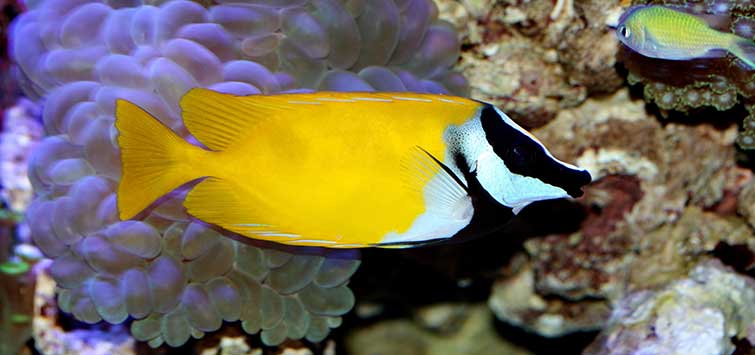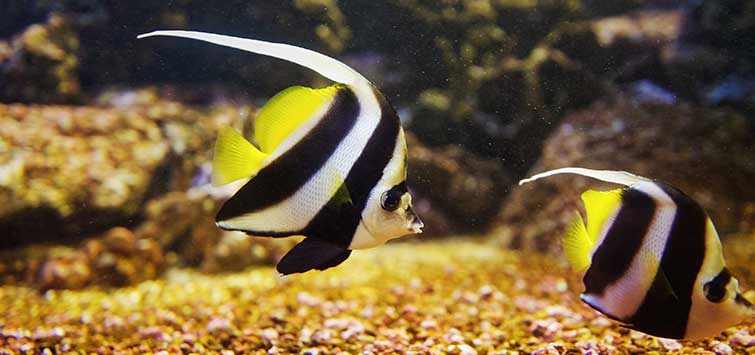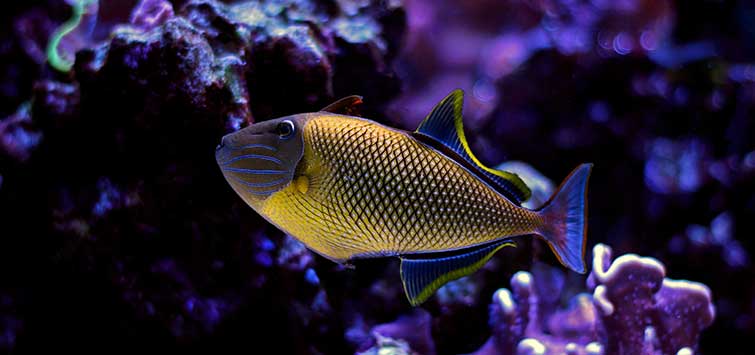The Salt Creep: A Warren of Righteous Rabbitfishes
Author: Jeff Kurtz
Like their terrestrial namesake, the rabbitfishes of the family Siganidae are peaceful, non-aggressive grazers that spend much of their time nibbling on “greens” in their environment—algae, that is, not clover. With their small mouths, large, endearing eyes, and sloping foreheads, rabbitfishes do, indeed, bear a passing resemblance to cute little bunnies. Though, ironically, the most recognizable aquarium species, the foxface rabbitfish Siganus vulpinus, tends to depart from this “rabbit-like model,” with its long, tapering snout giving it a more fox-like countenance.
Selling Points
Similar to the tangs, rabbitfishes have an oblong, laterally compressed body plan and many are vibrantly colored, which partially accounts for their appeal to aquarists. Another big selling point is their habit of consuming marine algae of all kinds, including the irksome Bryopsis “hair algae,” which plagues many a hobbyist. In addition, these fishes are extremely hardy and disease-resistant once acclimated to their new surroundings. With the popular aquarium species ranging in mature length from around 8 inches to well over 15 inches, rabbitfishes are good candidates for the medium to large aquarium. I wouldn’t recommend housing the smallest species in anything less than a 75-gallon tank. Always err on the side of more space!
Are Rabbitfishes Reef-Friendly?
Given their reputation as exceptional algae eaters, rabbitfishes would seem to be the ideal candidates for inclusion in a reef system. And, indeed, several species will adapt well to life in the mini-reef. But your humble Salt Creep would recommend proceeding with caution in this area.
I’ve found that herbivores, such as the rabbitfishes and tangs, occasionally misdirect their grazing behavior onto coral polyps (especially large polyp stony corals), Tridacna clam mantles, and other sessile invertebrates. It’s not that they’re necessarily trying to take a bite out of these invertebrates, but it’s just their instinct to graze continuously on the various substrates in their environment. As a result, any invertebrate that becomes a target for nipping may fail to expand for prolonged periods, to the detriment of its health.
One possible hedge against this irritating behavior in the reef aquarium is to provide a constant supply of dried marine algae—secured in an algae clip or between the two halves of an algae magnet—for the rabbitfish to graze on. With regular forage available, the fish may begin to resist the temptation to pick at invertebrates and turn its attention to the algae. It’s not a 100-percent-guaranteed solution, but it will, at least, help to refocus some of the misdirected grazing behavior.
These Rabbits Pack a Punch!
And don’t let their cuteness fool you! Rabbitfishes are armed with venomous dorsal and anal spines, which can deliver an extremely painful sting that reportedly can hurt for days (thankfully, I’ve never experienced this firsthand). These potent spines give rise to the alternate common name “spinefoot,” which suggests the dangers that waders face should they stumble upon one of these fish in the shallows.
Defense
While they don’t tend to use these armaments in an offensive fashion, they will use them defensively against a perceived threat—such as an aquarist’s hand carelessly placed in the tank during routine maintenance. Always know where your rabbitfish is located in the tank before placing a hand in the water. Better yet, place some sort of divider, such as a sheet of acrylic, between your hand and the rabbitfish whenever it becomes necessary to reach into the tank. Of course, hand feeding is a no-no, as well.
Transportation
Netting and transporting these species presents another opportunity to be accidentally stung, so extreme caution must be exercised whenever you’re trying to effect a capture. Rather than trying to scoop up a rabbitfish with a single net, which usually results in entangled spines, the recommended technique is to “herd” the specimen with two nets into a specimen box or other rigid container.
First-Aid for Rabbitfish Stings
· As with lionfish stings, the first course of action following a rabbitfish envenomation is to immerse the affected body part in hot water—as hot as you can tolerate but not hot enough to burn the skin. The high temperature will break down the proteins in the venom, which should help diminish the pain.
· Even if the pain subsides quickly, you should seek immediate medical attention following the sting to address the very real possibility of developing a secondary infection.
· It’s also important to note that, much like with bee stings, the severity of the reaction and the experience of pain following rabbitfish envenomation may vary considerably from one person to the next. There’s also the possibility that some sensitive individuals will experience a severe allergic reaction following the envenomation—another good reason to seek prompt medical attention after a sting.
Housing and Feeding Your Rabbitfish
As I’ve already mentioned, it’s best to err on the side of providing more tank capacity than you may deem necessary for a rabbitfish. Also, these timid fishes are prone to stress if they aren’t given ample hiding places that allow them to duck out of sight when they feel threatened. A good stack of live rock arranged in a “honeycomb” fashion that provides ample nooks, crannies, and caves will take care of this demand for places of concealment.
Feedings for these herbivores should be heavy on the marine greens. Avoid terrestrial greens—such as lettuce and spinach—in favor of frozen marine herbivore formulations, Spirulina flakes, and a steady supply of dried marine algae. Once acclimated, rabbitfishes will learn to accept just about any standard fare, including fresh, frozen, freeze-dried, and flake foods. But be sure to offer a variety of predominately vegetable-based foods to ensure that your rabbitfish’s nutritional needs are being met.
A Warren of Righteous Rabbits
So which rabbitfish species might you encounter in the aquarium trade? What follows is a sampling of species that are not only fairly common in the hobby but also excellent choices for the beginner to intermediate aquarist.
The Foxface Rabbitfish
Arguably the most familiar of the rabbitfishes, the foxface rabbitfish Siganus vulpinus (you may also see it included in the genus Lo) sports bright-yellow coloration over approximately two-thirds of its body, extending from just behind the pectoral fins through the caudal fin. Its head is white in base color with two distinct black bands. One band begins at the tip of the fish’s elongated snout, passes through the eye, and terminates just in front of the first dorsal spine. The second band forms a pronounced triangular pattern on the fish’s chest. Maximum length for this species is approximately 10 inches.
Upon introduction to new surroundings, it’s not uncommon for the vibrant colors of S. vulpinus to fade or become mottled. This is usually a temporary condition. However, be aware that environmental stress related to problems like poor water quality, insufficient swimming space, lack of hiding places, improper nutrition, or troublesome tankmates can also cause a noticeable color change. In this case, you’ll need to identify the source of the problem through process of elimination and take steps to remedy it.
The slightly more diminutive (reaching about 8 inches) one-spot foxface rabbitfish Siganus unimaculatus looks virtually identical to S. vulpinus, with the exception of a large dark spot located on the upper posterior of the fish’s body. This species is an equally desirable marine-aquarium inhabitant.
The Magnificent Rabbitfish
The magnificent rabbitfish Siganus magnificus (like S. vulpinus, sometimes included in the Lo genus) also favors S. vulpinus in general appearance; however, its overall color is whitish rather than yellow. Some yellow appears on the margins of the pectoral, anal, and caudal fins. The dark ocular band found on S. vulpinus is present on S. magnificus, but the triangular band is absent. S. magnificus also features a dark saddle-like marking on the dorsal half of its body. This species reaches approximately 9 inches in maximum length.
The Virgatus Rabbitfish
Representing the more rabbit-like appearance typical of most members of its family, the virgatus rabbitfish Siganus virgatus is more ovoid in shape than the foxfaces. It also gets quite large, approaching 12 inches in adult length, and must be afforded tank space accordingly. Its overall color is silvery yellow, and it sports two oblique, dark-brown bands, one extending from the chin through the eye and the other running from the base of the pectoral fin approximately to the base of the fourth or fifth dorsal spine. Fine blue lines form a delicate pattern on the head and dorsal half of the body.
The Orange-Spotted Rabbitfish
Also typically rabbit-like in appearance, the orange-spotted rabbitfish Siganus guttatus tops out at approximately 16 inches in length. Hence, this species can grow to be a real tankbuster and is best reserved for larger systems that offer ample swimming space. S. guttatus is dusky blue to silver in base coloration and is liberally speckled with small orange- to gold-colored spots. A much larger yellow spot appears at the base of the last few dorsal spines. Orange scribbles and dots ornament the head of this species.
Other Choices Abound
If you should happen upon another interesting rabbitfish species that isn’t described here at your local fish store and you think you might like to try your hand at keeping it (and there are many I haven’t touched upon in this column that are both beautiful and relatively easy to keep, even for beginners), by all means ask your dealer to put a hold on the fish—assuming this doesn’t conflict with store policy—while you do a little research to make sure you can provide the proper care and accommodations for the specimen. In all likelihood, you won’t be disappointed with your choice.
See the full article on TFH Digital http://www.tfhdigital.com/tfh/200710/#pg72

.png?h=595&iar=0&w=2781&hash=5FD5E69473BCC22199FBFA2FB71B6033)



